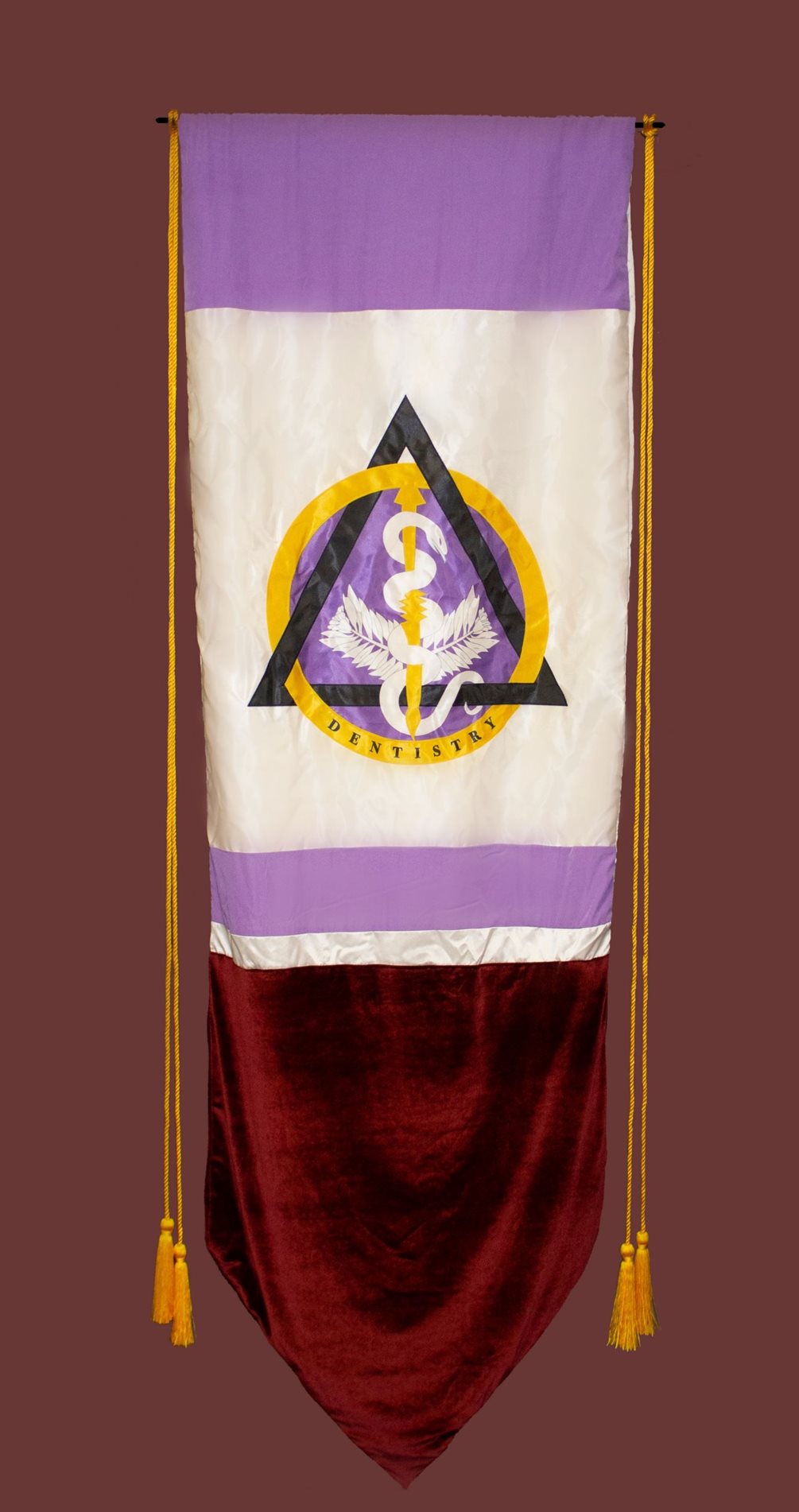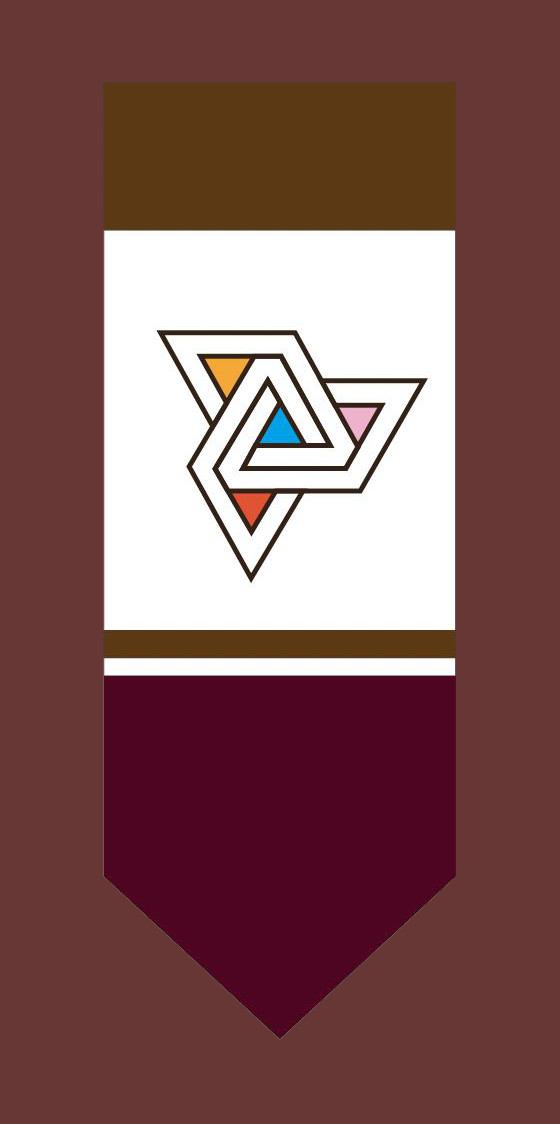The gonfalon, a flag that hangs from a crosspiece or frame, originated in the medieval republics of Italy as an ensign of state or office. Gonfalons have been adopted in many universities around the world as college or institutional insignias.
The gonfalons displayed represent the colleges of Texas A&M University. The colors of the University, maroon and white, are joined together in a pattern common to all of the flags. The top portion is the designated color for each unit. The white field serves as a background for the symbol of each.
To help identify each gonfalon, the discipline colors and description are as follows:
The gonfalons displayed represent the colleges of Texas A&M University. The colors of the University, maroon and white, are joined together in a pattern common to all of the flags. The top portion is the designated color for each unit. The white field serves as a background for the symbol of each.
To help identify each gonfalon, the discipline colors and description are as follows:
College Gonfalon | Discipline Color | Gonfalon Description | |
|---|---|---|---|
College of Agriculture and Life Science | |||
 | maize | On a ground of white appears an emerging sun of yellow and russet rays. Yellow, the discipline color of science, russet, the discipline color of natural resources, and the center orange, color of engineering, combine to illustrate the intellectual interest in human and biological systems and structures. The interweaving ring encompasses the dawn making a full circle of life. | |
College of Architecture | |||
 | brown | The College of Architecture is comprised of three departments, all dedicated to the advancement of the built environment: Architecture, Construction Science, and Landscape Architecture and Urban Planning. The central triangle, a key shape in the field of architecture, symbolizes power, resilience, and direction, which is tilted to reveal its dimensionality, a non-planar object manipulated by the designer in exploration of unique perspectives. The rectilinear towers that encompass the triangular shape represent the monumental constructions throughout the history of architecture. These structures are all placed upon the foundation, which symbolizes the beginning of architectural education and knowledge. The three ribbons represent the builder’s creativity (yellow), reliability (blue), and dedication (red), the essential values instilled within each student in the College of Architecture, leading towards a better world through the scope of knowledge and exploration. | |
College of Arts and Sciences | |||
 | dark blue | The symbol shows the connectivity of the distinct areas of knowledge in the College of Arts and Sciences. The components around the hexagonal ring are the domains of sciences, humanities, and social sciences. The design of the ring illustrates how these interlocking domains of learning and scholarship are united in the College of Arts and Sciences. | |
Mays Business School | |||
 | drab | The golden knot symbolizes unity and coordination of the disciplines of business administration. Surrounding the golden knot, a field of purple represents the rank of authority. The foundation of lozenges under the triangle illustrates the flow of order. | |
College of Dentistry | |||
 | lilac | The color lilac has been associated with dentistry since the 1800s, symbolizing compassion and inspiration. Upon it, rests the Greek Omicron, O, representing the first letter in “odont,” meaning tooth, along with an interlaced Delta representing the letter D for Dentistry. The inner-most component of the emblem depicts healing, as signified with a serpent intertwined around the ancient cauterizing rod of the Greek god of healing, Asceplius. Included in the emblem, are 32 leaves and 20 berries representing both the primary and secondary teeth. | |
College of Education and Human Development | |||
 | light blue | The flourishing flame blazoned with gold, light blue and royal purple signifies the burning zeal of the three missions of education--teaching, research and service. The hands hold the spiritual, social and intellectual flame of education. | |
College of Engineering | |||
 | golden poppy | As the triangles collaborate alongside each other, projecting a diamond shape, they depict the strong relationship between the diverse engineering disciplines. The use of mathematics, science and technology provide the foundation of solving today’s challenging ideas between and within each engineering department. The center illustrates a circuit board to express the continuing growth in technology and engineering today, resulting in new industries and opportunities. The cohesive elements of this design work together as a whole symbolizing communication, interaction, teamwork, and balance in Engineering as the green, blue and navy color palette represents energy, loyalty, wisdom, professionalism and ambition. | |
Bush School of Government and Public Service | |||
 | dark blue | The star symbolizes pride and heritage in our great state of Texas. The two lines on either side of the star represent our connection with the past, and with the future, in an effort to build on experiences from history, while contributing and presenting new opportunities to future generations. | |
School of Law | |||
 | purple | A widely accepted symbol of peace, the olive leaves highlight one of the most critical contributions of law and legal order to human development. Curving inwards, they also bring to mind the Aggie Ring – and the circle of fellowship and community it represents. Lady Justice symbolizes the values our graduates bring to bear in their careers: a spirit of objectivity (blindfold), an unwavering commitment to fairness (scales), and the strength necessary to pursue it (sword). The six stars, finally, represent Texas A&M’s Core Values – Leadership, Respect, Loyalty, Excellence, Selfless Service, and Integrity – essential requirements of not only members of the legal profession, but all those who study the law and seek to advance justice, fairness, and the Rule of Law. | |
Naresh K. Vashisht College of Medicine | |||
 | hunter green | The white field provides a background for the Aesculapian staff and serpent, long used as the symbol of the healing arts. The green color is the same displayed on the hoods of the robes worn for the degree of Doctor of Medicine. | |
College of Nursing | |||
 | apricot | The stars on the College of Nursing gonfalon represent caring, innovation and empowerment, while the cross symbolizes the origins of nursing. The candle honors the founder of nursing, Florence Nightingale. | |
College of Performance, Visualization and Fine Arts | |||
 | brown | The center of the design is a Penrose triangle, which is a continuous triangle, and an impossible 3D shape. The triangle combines math and creativity through the optical illusion it creates. The extensions of the triangle symbolize growth in all directions, while the overall triangular form communicates unity and continuity. | |
Irma Lerma Rangel College of Pharmacy | |||
 | olive green | The mortar and pestle on the College of Pharmacy gonfalon symbolize the tools of traditional pharmacy. The Rx is from the Latin, "Take thou." | |
School of Public Health | |||
 | salmon | The anchor and caduceus are adapted from the national Public Health Service, which evolved from the Marine Hospital Service to the Public Health and Marine Hospital Service, and finally became the U.S. Public Health Service. The star represents the linkage of the School of Public Health with the Texas A&M Health Science Center and the State of Texas. | |
College of Veterinary Medicine and Biomedical Sciences | |||
 | gray | Resting upon a ground of purity, a white snake stands for the science and art of prevention, cure or alleviation of disease and injury to animals. It is found entwined around a herald's green staff--the symbol of service. The golden radiant triangle atop the Aesculapius illustrates the breadth of veterinary medical science. | |